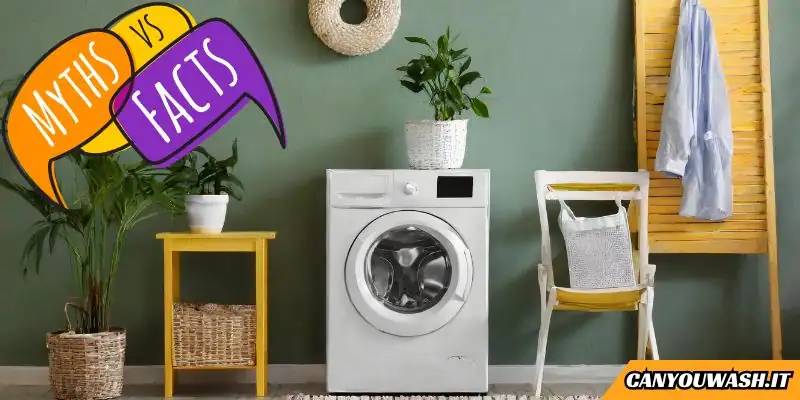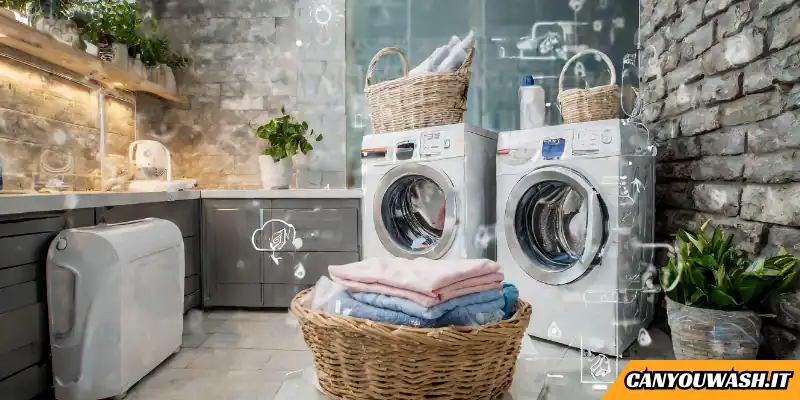Common laundry myths busted: hot water isn’t always necessary (cold water works well), using excess detergent doesn’t guarantee cleaner clothes (follow recommended amounts), and dryer sheets aren’t essential for softness (sorting and fabric care matter more).
What You Will Find in This Guide:
Laundry is a household chore that we all have to tackle, but are we doing it right? Over the years, various laundry myths have taken root, passed down through generations or shared among friends.
In this blog post, we aim to debunk some common laundry myths, helping you make informed decisions about how to care for your clothes and maintain your laundry appliances.
10 Most Common Laundry Myths Debunked
There are several laundry myths that have been passed down through generations or spread through word of mouth.
It’s important to separate fact from fiction to ensure you’re taking proper care of your clothes and laundry appliances.
Here are some common laundry myths busted:
- Myth: More Detergent = Cleaner Clothes:
- Busted: Using too much detergent can lead to soap residue buildup on clothes and in the washing machine. It’s best to follow the manufacturer’s guidelines on the detergent packaging for the correct amount.
- Myth: Hot Water is Always Better:
- Busted: While hot water can be effective for removing certain stains and killing bacteria, it’s not always necessary. Many modern detergents are formulated to work well in cold water, and using hot water excessively can cause colors to fade and fabrics to wear out faster.
- Myth: Dryer Sheets Are Necessary for Softness:
- Busted: Dryer sheets can add a pleasant scent and reduce static, but they are not essential for softening clothes. Fabric softeners and dryer balls are alternative options that can achieve similar results.
- Myth: Washing Clothes Inside Out Protects Colors:
- Busted: While turning clothes inside out can help prevent friction and protect prints or embellishments, it doesn’t necessarily preserve colors. Using cold water, sorting clothes by color, and following care instructions are more effective ways to prevent color fading.
- Myth: All Stains Require Hot Water:
- Busted: While hot water can be effective for certain stains, it’s not suitable for all. Some stains, like blood or protein-based stains, may set in hot water. Always check the care label and use an appropriate stain treatment method.
- Myth: Dry Cleaning is Always Necessary for “Dry Clean Only” Clothes:
- Busted: Some “dry clean only” labeled clothes can be hand-washed or machine-washed on a gentle cycle. Always check the care label and fabric composition. If in doubt, seek professional advice.
- Myth: Bleach Makes Whites Whiter:
- Busted: While bleach can help remove stains and disinfect, excessive use can weaken fibers and cause yellowing. Opt for oxygen bleach for a gentler alternative, and use bleach sparingly.
- Myth: All Clothes Shrink in the Dryer:
- Busted: Not all fabrics shrink in the dryer. While natural fibers like cotton and wool are more prone to shrinking, many modern fabrics, such as those with synthetic blends, are designed to be dryer-safe. Always check care labels and use the appropriate settings.
- Myth: Washing Bras in the Machine Ruins Them:
- Busted: While machine washing can wear out bras faster, it’s not inherently damaging. Use a mesh lingerie bag and choose a gentle cycle to protect delicate fabrics. Air-drying is recommended to prolong the life of bras.
- Myth: Air Drying is Always Better than Machine Drying:
- Busted: While air drying is gentler on clothes and can prevent shrinking, some fabrics benefit from the fluffing action of the dryer. Additionally, using a low heat setting in the dryer can be a compromise between air drying and machine drying.
Final thoughts 💭
By dispelling these common laundry myths, you can approach your laundry routine with a clearer understanding of what works and what doesn’t. Always check care labels, follow recommended guidelines, and stay informed about the best practices for maintaining your clothes and laundry appliances. Happy laundering!




Leave a Reply